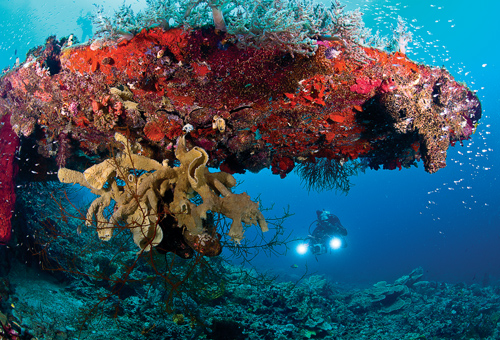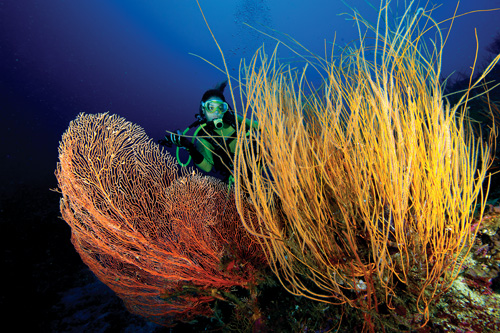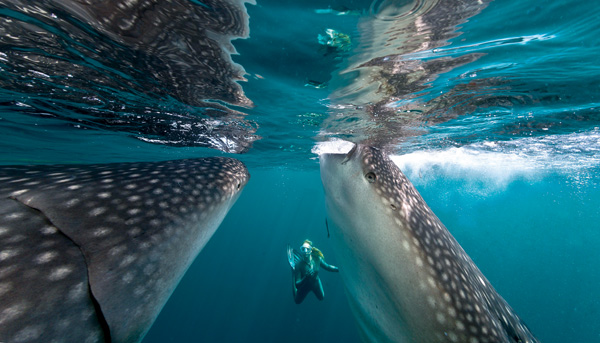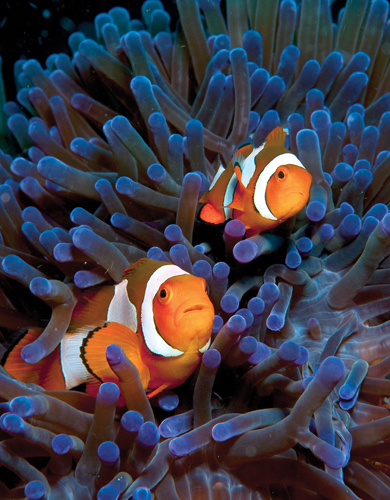Exploring Indonesia’s Ancient Sea
Site of the country’s largest marine park, Cenderawasih Bay boasts endemic species and biodiversity that make it unique in the world ocean and worthy of your dive site bucket list
Text and Photography by Michael AW

Rising above an indigo sea, the fog-shrouded Arfak Mountains evoke the image of a place time forgot. There, in the northern province of Papua and West Papua you will find a wedge-shaped expanse of water fringed by waving palms, white sand beaches, mangrove swamps and coral limestone cliffs. Nestled in the equatorial seas of Cenderawasih Bay, in the eastern Indonesian Archipelago, it is as remote as the Baliem Valley in New Guinea, and today is unique in the world ocean thanks to the bump and grind of tectonic plates millennia ago.
Cenderawasih (also Cendrawasih) Bay is easily located on a map: it dominates the northeastern coastal area of West Papua and helps define that land mass in the form of a bird’s neck. It’s home to an abundance of marine life comprising every coral reef imaginable, from fringing to barrier reef, from atoll to patch reef, and lots of shallow water reef mounds to boot. The fringing reefs here have been scientifically documented as the last remaining pristine reefs on the planet. Recognizing the value of this remarkably untouched marine environment the Indonesian government established Taman Nasional Teluk Cenderawasih (TNTC) in August of 2002. It is the country’s largest marine park, at 1,453,500 hectares (14,535 square km).
The park management plan reflects a system of 14 tourism zones but its remote location is perhaps the park’s most effective guardian. Few tourists visit each year and the local population amounts to just 20,000 or so inhabitants. You can travel the entire length and breadth of the park’s land area on the Wandammen Peninsula and see few people the entire time. Modern development is almost non-existent. There are no Four Seasons or Hilton hotels, no water sports centres, not even a day boat for local water tours.
Tectonic Influence
Between three and fourteen million years ago, slivers of land moved by Earth’s tectonic plates sealed the mouth of Cenderawasih Bay, blocking the flow of oceanic larvae. In time these barriers broke open but the shallow sill that remains and sheer size of the bay limit water circulation and the spread of planktonic larvae to many of the reefs within. As a result, the bay’s marine life evolved in isolation.
Through the millennia, rising and falling sea levels saw the emergence and disappearance of fishes and corals in the bay. In the Pleistocene era when sea levels dropped 400 feet (120m) below the present level, shallow reefs and their inhabitants perished and were replaced by deep water animals that acclimatized to their new environment. Then, as sea levels rose again to flood the dried reef zone these same animals followed the rising sea to inhabit water 10 to 65 feet (3 to 20m) deep. In these shallows they enjoyed little competition in the daily dance of survival and hence a species such as Burgess’s butterflyfish (Chaetodon burgessi), normally found in 200 to 260 plus feet (60 to 80m) of water elsewhere, is commonly seen in Cenderawasih Bay in just 30-foot (10m) depths.
Marine scientists have established that until geologically recent times the bay was isolated from the flow of Pacific tides. This reality categorizes Cenderawasih Bay as an ‘ancient sea’ with a high percentage of endemic fish and coral species found nowhere else in the marine world. Dr. Gerald Allen, Conservation International’s senior consulting ichthyologist, describes the bay as “the Galápagos of the East”, based on documented findings of an “evolutionary cauldron” of new and unique corals, shrimps and fish species. Extensive surveys have documented 995 species of fish and over 500 species of corals, which amount to about 10 times more than the combined total of the entire Caribbean.

Fish Lure
Lured by the thought of new discoveries, I made two sojourns to this primordial sea over the past two years.
There’s something decidedly adventurous about flying through five airports in three days, hopping from a Singapore Airlines ‘ginormous’ double deck Airbus A380 to Express Air’s 18-seater turbo prop, to get to Manokwari in West Papua. Talk about time travel! On arrival we were whisked away to a quaint harbour next to a raucous fish market where we boarded the MSY Seahorse along with ‘tons’ of camera equipment and high expectations for the 10-day Cenderawasih Marine Park expedition ahead.
Though my hope was to explore sites unseen by divers and to capture images of the deep water animals now living happily in the shallows, the major attraction at Cenderawasih, it turned out, was the recently discovered congregations of whale sharks (Rhincodon typus) around local fishing platforms (bagans) in the southern part of the reserve. Readers of DIVER will know that whale sharks congregate in a number of places that include the Galápagos, Belize, Western Australia’s Ningaloo reefs, and Donsol in the Philippines. But these sharks are only visitors, departing after one to three months. What we’ve learned from local fishermen is that the whale sharks of Cenderawasih are year-round residents.
Our expedition through this enchanting and unspoiled area of Indonesia began with navigational charts and other guides that included co-ordinates taken from Diving Indonesia’s Bird’s Head Seascape, a book published by Saritaksu and Conservation International. From Manokwari, Captain Txus Reiriz steered Seahorse south on a 12-hour overnight sail to Tridacna Atoll, a reef formation 15.5 miles (25km) east of Tanjung Busurua, which is off the northeast tip of the Wandammen Peninsula.

Vast Wilderness
We began with a couple of surveyed sites before venturing to a few of our own. Over the vastness of the atoll, we found layers upon layers of mighty plate corals in pristine condition; the reef tops are adorned with some of healthiest hard coral meadows we have ever seen. Dramatic vertical walls with prolific sea whips and colourful sponges abound on the outside reefs. We did find pockets of severely damaged reefs, possibly from dynamite fishing or coral bleaching events. Many were in various stages of recovery, scattered with youthful colonies of staghorn corals. Before the trip we were told to expect low fish biomass (in layman terms, not so many fish). Fish density was low at a few sites, but repeatedly we encountered massive schools of fishes along ridges, especially where tidal or ocean currents converge. One afternoon, while shooting a panorama of a field of hard corals, I observed damselfishes congregating to spawn. There were gazillions of them! I was spellbound and left only when my tank ran dry.
Exploring the atoll we continued to find healthy reefs, most populated by intact hard corals stretching out indefinitely along the slopes of the fringing reefs. We had two shark sightings and recorded several species of reef fishes, including barracuda, eagle rays and several green and hawksbill turtles. A park ranger along on our trip offered anecdotal information about dugong and salt water crocodile sightings. We knew they were there but we focused our search on the rare deep water and endemic fishes in these waters. I was delighted to photograph a few endemic species such as the Cenderawasih fairy wrasse, some Monikae fusiliers and a new species of Long-nosed butterflyfish. I found the deep water Burgess butterflyfish in just 40 feet (12m) of water.
Burt Jones, Conservation International’s principal photographer on our expedition told us not to expect colourful soft corals typical of Raja Ampat further to the west. But one afternoon diving near the Napen Peninsula, we found the King Solomon’s mines of soft coral along a submerged ridge complex formed by two tiny islets and three rocky outcrops that barely broke the surface. The site was indescribable, rather like some mad hodgepodge painted by the likes of van Gough, Monet and Picasso, all on steroids. The corals were vying for space with hefty bushes of orange, red and yellow whip corals and gorgonian sea fans adorned with mandarin-coloured tunicates. The lavish plumes of soft coral seemed to defy gravity, utterly out of proportion to their surroundings and just plain out of place. It was a phantasmagoria worthy of Lewis Carol or Dr. Seuss. In fact, I named the site Dr. Seuss Reef. Fantasia took on new meaning.

Whale Shark Ride
Any exploration to Cenderawasih should include at least a day interacting with the resident whale sharks (Rhincodon typus). We stayed for four. These gentle giants are attracted to local fishing platforms (bagans) like bees to honey. Bagans are semi-mobile platforms located around Kwatisore Bay in the southern end of the park. At dusk, massive nets are lowered beneath the platforms to a depth of about 60 feet (18m). Surface floodlights attract ikan puri, a small baitfish, in the millions, which they harvest the next morning. Excess catch left in the net becomes breakfast for the whale sharks who have learned to suck the anchovy-like fish through the mesh of the net. Perhaps to amuse themselves or for a little companionship, the fishermen feed bucket loads of ikan puri to the sharks. From this we now know that whale sharks are opportunistic feeders that associate this human contact with food. Cenderawasih Bay is the first location in the world to document such behaviour.
Over four days we encountered 20 individual whale sharks beneath five bagans. We’d start early in the morning and seldom finish shooting until dusk. Typical of sharks, lions and even humans, prime feeding times are in the morning and the evening before sunset. At 7 a.m. we’d typically find two to three juveniles casually plucking baitfish from the net but by 10 a.m. there was a crowd. Likely as many as 10 animals, from six to more than 30 feet (2-12m) in length, would congregate to feed from the nets or gobble handouts from the fishermen. This was followed by a noon time lull with just one or two juveniles hanging around for handouts. By 4 p.m. the rays of late afternoon sun were like the ringing of a dinner bell and more than any other time the sharks seemed to abandon their table manners rushing in with mouths agape, climbing on top one another to take in as much food as possible before nightfall. Over the course of our four days with the sharks all of us were able to get up-close and make eye contact with them whether we were on SCUBA or snorkeling. Though large and potentially dangerous, the animals were gentle and always moved their powerful tails to avoid contact with their human friends. They seemed unfazed by our presence in the water and occasionally they would rise vertically alongside us seemingly to pose with their clumsy, bubble-blowing friends.
On one occasion I was shooting three sharks waiting for handouts from the fishermen on their bagan when, unknown to me, two bigger sharks approached from behind. I felt a push and in the next moment I was the ham in the sandwich, metaphorically speaking. Five sizeable animals, each weighing about 15 tons, were jostling for snacks and there I was in the middle of the scrum. It was a rather sloppy moment as their large fleshy mouths opened and closed around me but true to form, they were aware of me, and gentle, and I was able to move away by dropping beneath them and swimming out of the way. I was taken aback by the experience but with a grin on my face as wide as the mouth on any one of those whale sharks. It was an unforgettable moment, a whale of a tale that I’ll talk about for the rest of my life.
Besides knowing that whale sharks surface to feed on plankton and small fishes very little else is understood about them. We do know they breathe through gills, that they’re cold-blooded and they’re the biggest fish in the ocean. Their year-round congregation and feeding at the fishing bagans is the first time such behaviour has been observed. We are unsure if this population is local. We know shark fin merchants would scoop them out of this protected area given half a chance. In a bid to better understand and protect these animals Mark Erdhmann of Conservation International successfully tagged five sharks that are providing invaluable data on their daily diving and ranging behaviours. Given names, the mature pair are Rachel and Javas and they are in company with the three younger males: Ren, Stimpy and Cumulus.
It’s hoped the tags and the data they transmit will help to demystify these magnificent animals. We must do all that we can to protect their well-being and their habitat to ensure their longevity and for our future generations. Cenderawasih Bay is a global treasure and perhaps more. Ocean icon Valerie Taylor called it the eighth natural wonder
of our world.
 Cenderawasih Bay Marine Park
Cenderawasih Bay Marine Park
Location:
Southwest quarter of Cenderawasih Bay, Irian Jaya
Coordinates: 01°43’-03°22’ S and 134°06’-135°10 E
Status: National Park / IUCN Category: II
Features: The park comprises the southwestern quarter of Cenderawasih Bay, which lies to the east of the isthmus connecting the Vogelkop Peninsula to the mainland. The park falls within the administrative districts of Manokwari and Nabire. It can be accessed by sea from the towns of Manokwari and Nabire, situated 60 miles (95km) north and 24 miles (38km) east, respectively. Air transport is available to and from Manokwari, Biak and Nabire.
For More information:
Nabire Office: 15, Jalan RE Martadinata, Nabire 98817 Irian Jaya Indonesia
Tel / Fax: (+62-967) 21289
Email: wwfnabire@jayapura.wasantara.net.id
Manokwari Office: (+62-986) 212784
Email: wwf-mkw@manokwari.wasantara.net.id
Leave a Comment







